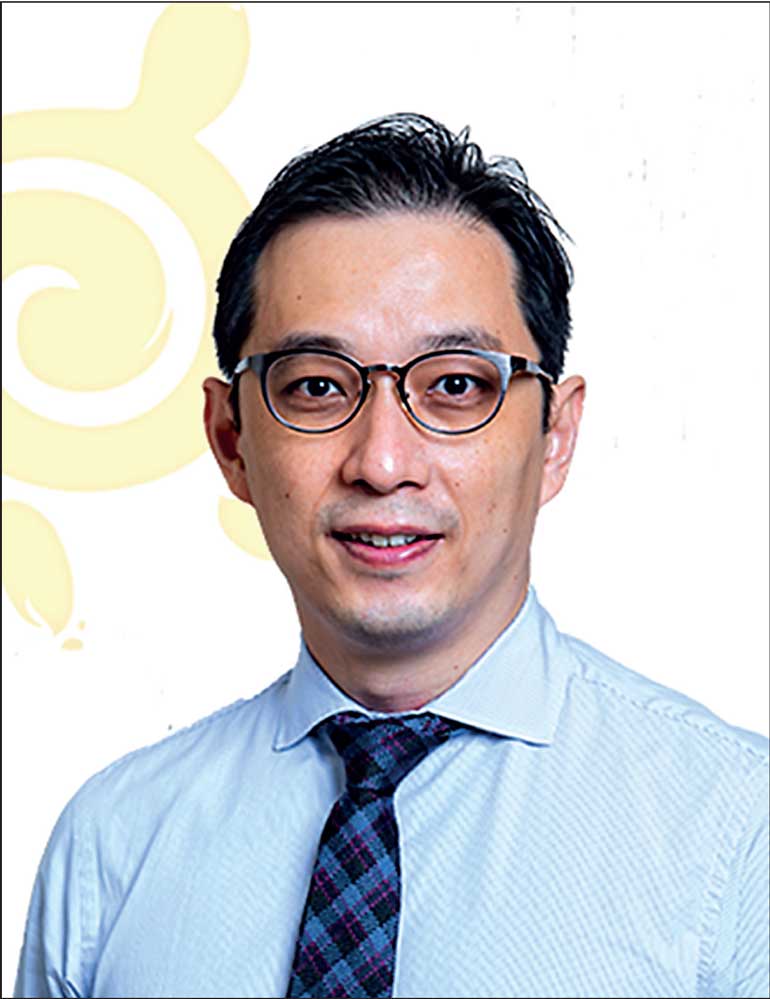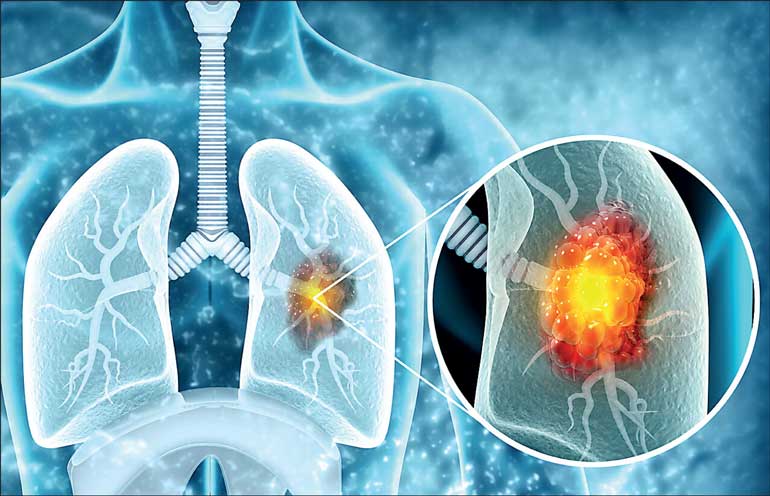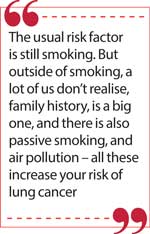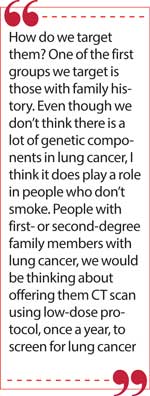Wednesday Dec 17, 2025
Wednesday Dec 17, 2025
Tuesday, 28 October 2025 00:00 - - {{hitsCtrl.values.hits}}

Parkway Hospitals Singapore Senior Consultant, Medical Oncologist Dr. Wong Siew Wei

A proportion of it is not related to cigarette smoking as a risk factor
By Fathima Riznaz Hafi
 Though smoking presents as the notorious contributor to lung cancer, genetic factors, passive smoking, and air pollution are all contributors as well. Non-smokers, in fact, form a large segment of people who can develop this type of cancer, reveals Parkway Hospitals Singapore Senior Consultant, Medical Oncologist Dr. Wong Siew Wei.
Though smoking presents as the notorious contributor to lung cancer, genetic factors, passive smoking, and air pollution are all contributors as well. Non-smokers, in fact, form a large segment of people who can develop this type of cancer, reveals Parkway Hospitals Singapore Senior Consultant, Medical Oncologist Dr. Wong Siew Wei.
“The issue with lung cancer, especially in the Asian context, is a proportion of it is not related to cigarette smoking as a risk factor. There is a bit of a genetic component but it’s not well-described. For example, in countries like Singapore, Hong Kong and China, only about 10-15% of women patients would have a history of smoking. The other 80-85% have no issue of smoking, yet they have lung cancer. I believe in Sri Lanka if we have female lung cancer patients, chances are they have not smoked much as well.
“The usual risk factor is still smoking. But outside of smoking, a lot of us don’t realise, family history, is a big one, and there is also passive smoking, and air pollution – all these increase your risk of lung cancer.”
Speaking at a press meet in Colombo, Dr. Wong further revealed, “In fact, there is radiation from the environment. You may say this is a clean island, but there is radiation from the soil. In some communities, they use biofuel for cooking, wood fuel, charcoal fuel – which raise your risk of lung inflammation, chronic lung illness like tuberculosis, and long-term infection of the lungs – all of which cause injury to the lungs and increase your risk of lung cancer as well.”
How do we pick up this cancer at an earlier stage?
The issue comes down to how we pick up this cancer at an earlier stage. Because this is not the typical segment of the population who would actively look out for lung cancer; unlike the smokers who would consider doing scans to check for cancer.
 “If we go back more than 12 years ago, the Europeans and Americans have proven that doing CT scans for high-risk groups, especially those who smoke a lot, will pick up more lung cancer cases at an earlier stage; that improves survival, compared to doing chest x-ray. If we only focus on screening smokers, we’re going to miss out on these people who never smoke. And they all come back with Stage 4 lung cancer before we find it. So the effort has been put into place to identify and catch lung cancer earlier in people who don’t smoke,” he said.
“If we go back more than 12 years ago, the Europeans and Americans have proven that doing CT scans for high-risk groups, especially those who smoke a lot, will pick up more lung cancer cases at an earlier stage; that improves survival, compared to doing chest x-ray. If we only focus on screening smokers, we’re going to miss out on these people who never smoke. And they all come back with Stage 4 lung cancer before we find it. So the effort has been put into place to identify and catch lung cancer earlier in people who don’t smoke,” he said.
“How do we target them? One of the first groups we target is those with family history. Even though we don’t think there is a lot of genetic components in lung cancer, I think it does play a role in people who don’t smoke. People with first- or second-degree family members with lung cancer, we would be thinking about offering them CT scan using low-dose protocol, once a year, to screen for lung cancer.”
Dr. Wong is part of this program in Singapore that is partially funded by pharmaceutical companies and sponsored by him as well.
He says, hopefully this would pick up more cases, noting that in countries like Taiwan, the incidence of stage 4 lung cancer in women has dropped from 65% to 45% over a 10-year period, when they implemented this nation-wide exercise. Therefore, the more cases picked up at an earlier stage the more chances to cure the cancer.
New drugs
“For many cancers there are lots of new drugs that we have to keep up with. And we are no longer just relying on chemotherapy. We still use a bit of chemotherapy but we have very good options for targeted therapy. That means we identify a specific target and using that information, we match the target to the correct treatment for each patient. Now we have at least nine targets that we look out for in lung cancer that have specific drugs that we use with high efficacy.”
How do they test for this? Routinely they would use a very sophisticated machine to test for all these mutations in one go. They don’t test for mutation A, followed by mutation B, followed by C, etc. because if they do it that way it will be take up too much time, and it will use up too much material for testing, the doctor explained.
When they get material for lung cancer testing, usually it’s a small sample and they have to use it in a very careful way. That’s where the gap lies in countries that have not developed their health system very well. “I’ve been speaking to some of the contacts here in Sri Lanka; I think to do this kind of test in the country itself it’s not so well-established – they are relying on regional countries to help run these tests. This would be problematic because logistically we have to have the specimen shipped around, there’s more waiting time. There’s a chance the specimen gets lost along the way. So the local patients have a huge challenge in this regard.”
 “There are other ways we can overcome this in Singapore – sometimes we test for these mutations using blood drops – we draw a few drops of blood, then from the blood we try to identify DNA that belongs to the cancer; if we can find them, we can run the same algorithm, we can get the same information. The accuracy is very high but the chance of picking up the mutation, because we’re detecting small fragments of DNA in the blood – it’s about 80-85% for stage 4 cancer. So finding targets matching with the best effective drugs helps.”
“There are other ways we can overcome this in Singapore – sometimes we test for these mutations using blood drops – we draw a few drops of blood, then from the blood we try to identify DNA that belongs to the cancer; if we can find them, we can run the same algorithm, we can get the same information. The accuracy is very high but the chance of picking up the mutation, because we’re detecting small fragments of DNA in the blood – it’s about 80-85% for stage 4 cancer. So finding targets matching with the best effective drugs helps.”
Then they have other classes of drugs – like immunotherapy; it has been used for more than six years in Singapore. And in recent years they are seeing a newer class of drugs. For example, they have antibodies which will stick to certain targets in the cancer but these antibodies are engineered with strong chemotherapy attached to it. When it is engineered that way doctors can deliver very potent chemotherapy directly to where the cancer cells are sitting, without causing too many side effects to the patients. These are a few types of new therapeutic paths that they have access to in Singapore, which will change how they improve the patient’s outcome.
How you use these drugs
The other thing that is very big in any cancer is how you use these drugs. “We may have very good drugs but how we use it is very important. If you use it too late, the patient never benefits from it. So we are getting smarter in how we use this drug, especially in early stage lung cancer. For lung cancer patients who are suitable for operation, a proportion of them will be recommended for treatment using drugs and immunotherapy, prior to surgery. And that’s been proven to improve the outcome as well.
“For this to happen we have to work very carefully with our lung specialists, our surgeons, we have to capture these cases early so that they have the chance to benefit from the correct type of drugs – because the same drugs we deliver after chemotherapy, paying the same amount of money, the benefit may be less. So timing is very important – just like when you’re cooking, you put a different type of ingredient or at the wrong timing the dish will turn out differently.
The other way we are also learning is how much drugs we have to give to achieve the optimal outcome.”
Sometimes they may only have to give the drugs for one year, sometimes they have to go for two years. So newer generation drugs will tell how much to give this.
“Obviously, there are pros and cons – if we give too little they won’t get any benefit, but we are getting smarter at doing this.”
Oncologists will head towards a more precise drug delivery with technology advancement. In situations like breast cancer or lung cancer doctors are using specialised tests, a bit like Artificial Intelligence to tell them which patients are at higher risk of relapse after chemotherapy, and which one of them will benefit from using chemotherapy or other drugs. With this kind of information, eventually they will move to a new lung cancer treatment phase and will be able to reduce giving drugs to everyone – the doctors can select who are the higher risk ones and give it to them, and keep the lower risk patients away from it.
Gastrointestinal cancer – what are the organs involved and what’s going on there?
Dr. Wong’s areas of expertise include prostrate, kidney, bladder, upper gastrointestinal, and lung cancers. He was asked about the gastrointestinal tract and the issues therein.
The whole gastrointestinal tract – starts from the mouth, the oesophagus, stomach, small intestine, large intestine, bile duct, gall bladder, liver – all of these are considered gastrointestinal; and all of these can have cancer. And with different risk factors, he explained.
Liver cancer in a lot of Asian countries is related to Hepatitis B infection, while in Western countries it’s Hepatitis C because of drugs and other risk factors. “For liver cancer, Asian countries may have more experience in treating it because we see a lot more Hep B patients in our population. We are learning to treat this cancer better, using immunotherapy, and directly injecting treatment into the liver. All these will improve the patient’s outcome.”
Does Hepatitis infection have a long-term effect on the liver, and does it cause cancer?
 “There are quite a few types of Hepatitis virus – we have Hepatitis A, B, C, D, and even E. Hepatitis A, we get it from food. Usually the patient is sick for a few days and then he recovers. Hepatitis B is very different. We have tablets to control this virus but the virus can never be 100% cleared from the liver. It may be hiding in the liver cells, despite you taking the antivirus tablet. While you’re on the anti-virus tablet the virus does not get out into the blood that much, the person is not infectious, unlikely to pass on the Hep B to someone else. But it is still hiding in there.
“There are quite a few types of Hepatitis virus – we have Hepatitis A, B, C, D, and even E. Hepatitis A, we get it from food. Usually the patient is sick for a few days and then he recovers. Hepatitis B is very different. We have tablets to control this virus but the virus can never be 100% cleared from the liver. It may be hiding in the liver cells, despite you taking the antivirus tablet. While you’re on the anti-virus tablet the virus does not get out into the blood that much, the person is not infectious, unlikely to pass on the Hep B to someone else. But it is still hiding in there.
“So because it stays in the liver, there is long-term damage to the liver cells DNA and over time this can lead to cancer; especially if there are other problems happening in the background, like alcohol consumption, things that can stress out the liver cells. Those are the usual situations that we encounter in Asian patients. It is common. Typical liver cancer patients in Asian countries are Hep B patients. So Hep B is unique.
“Hep C is more common in Western countries, but the drugs that we have against Hepatitis C work quite effectively. It can completely eradicate Hep C virus from the body. It is Hep B that causes a lot of problems,” Dr. Wong explained.
Other conditions can cause liver injury. In Western countries they have fatty liver, where the fatty acids in the body create a lot of stress on the liver cells and over time, after many years, through long-term inflammation and scarring, it can lead to cancer as well, he added.
The doctor was asked about the reason behind the presence of jaundice in a patient. He explained that jaundice results from any condition that stresses out the liver significantly; it can be liver injury from paracetamol overdose, to severe Hepatitis A infection, to a lot of cancers inside the liver itself, to even blockages of the bile duct because of stones or cancer pressing on the bile ducts.
Signs of liver cancer
Asked if there are any symptoms of liver or lung cancer that we can look out for, Dr. Wong replied, “The issue is you don’t get symptoms at an early stage. If you have a 2 cm spot sitting in your lungs, usually the patient won’t feel anything. That’s where cancer screening is important – for people who don’t feel anything; who feel normal; we need to pick up the cancer when it’s small; if we pick up the cancer when it’s big, usually it’s already Stage 3 or even 4 cancer when it’s too late. By the time someone has pain in the back of the chest or is coughing out blood, usually the cancer is quite big.
“For the liver, just like for the lungs, we don’t have signs in its early stage. If you have a 2 cm tumour sitting in your liver, you’re not going to feel it. Then by the time you feel it, it’s usually very advanced. With a sick liver, you will feel tired, and there’s a lack of appetite. When it’s very big, your liver will swell, there will be changes in the abdomen, and you may turn yellow – those are very late signs. By the time the pain starts in the liver, it’s usually quite late. The chance of cure is lower.”
Dr. Wong added that they have new treatment but the chance of cure is a lot less than if the cancer was identified earlier, and reiterated that that’s why for certain risk groups, like for Hepatitis B patients, in Asian countries, doctors recommend ultrasound of the liver every six months, as part of screening. They screen people who don’t have symptoms. Once you have symptoms, it’s usually a bit late, he cautioned.